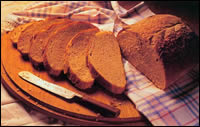Ferment:
2.5 dl lukewarm (37-40 °C) water
2.5 g yeast
2.5 dl rye flour
48 hours later:
25 g yeast
7 dl lukewarm water
3 tbsp oil
ca 2.5 1 (ca 1.3 kg) rye flour or
a mixture of wheat and rye flour
2 tsp salt
2 tsp sugar
The ferment with its long rising period adds to the taste of rye bread, gives
it a moist texture, and keeps it from drying out. You can make a double quantity
of the ferment, and keep the rest in an airtight container in a freezer or a
fridge. Bread made solely from rye flour is heavy and dense and does not rise
very well. This is why rye flour is usually mixed with wheat flour in equal
measures. Though the taste of rye will predominate, the bread will rise better
and will therefore be more 'airy'.
Measure the ferment flour into a bowl, add the water, mix well and leave covered
with cling film in a warm, draught-free place to ferment. On the third day crumble
25 g yeast into a large bowl, add a little water and sugar and mix until it
is dissolved. Now add the rest of the water, oil, ferment and salt, and then
about 2 1 of the flour. Knead, adding flour, until the dough no longer sticks
to the bowl or your hands. Sprinkle the dough with flour, cover it, and leave
to rise in a warm place for 50-60 minutes. Outturn the dough onto a table sprinkled
with flour, and gradually knead in the remaining flour, until the dough no longer
sticks to the table. Mould the dough into two smooth loaves, place them on baking
sheet covered with a greaseproof paper, cover them with a tea-towel and leave
to rise in a warm place for about 30 - 40 minutes. Prepare oven to 175 °C,
brush loaves with lukewarm water or milk, bake on the lower shelf for 50-60
min. You can find out whether the bread is ready by the following method: take
the loaf out of the oven, turn upside down and tap a few times; if you hear
a hollow sound, it is ready, if the sound is muffled, it should be placed back
into the oven. Cool on a rack under the tea towel.
The short story of the Estonian Cuisine
|
 |
 |



